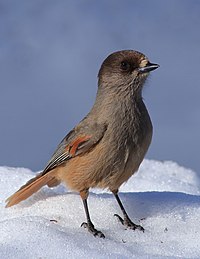
Photo from wikipedia
Some animals hide food to consume later; however, these caches are susceptible to theft by conspecifics and heterospecifics. Caching animals can use protective strategies to minimize sensory cues available to… Click to show full abstract
Some animals hide food to consume later; however, these caches are susceptible to theft by conspecifics and heterospecifics. Caching animals can use protective strategies to minimize sensory cues available to potential pilferers, such as caching in shaded areas and in quiet substrate. Background matching (where object patterning matches the visual background) is commonly seen in prey animals to reduce conspicuousness, and caching animals may also use this tactic to hide caches, for example, by hiding coloured food in a similar coloured substrate. We tested whether California scrub-jays (Aphelocoma californica) camouflage their food in this way by offering them caching substrates that either matched or did not match the colour of food available for caching. We also determined whether this caching behaviour was sensitive to social context by allowing the birds to cache when a conspecific potential pilferer could be both heard and seen (acoustic and visual cues present), or unseen (acoustic cues only). When caching events could be both heard and seen by a potential pilferer, birds cached randomly in matching and non-matching substrates. However, they preferentially hid food in the substrate that matched the food colour when only acoustic cues were present. This is a novel cache protection strategy that also appears to be sensitive to social context. We conclude that studies of cache protection strategies should consider the perceptual capabilities of the cacher and potential pilferers.
Journal Title: Biology Letters
Year Published: 2017
Link to full text (if available)
Share on Social Media: Sign Up to like & get
recommendations!